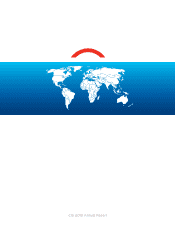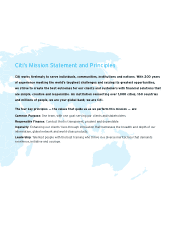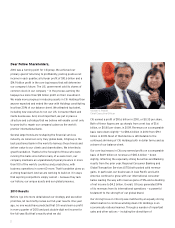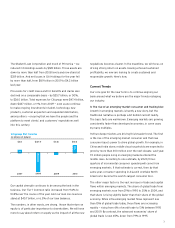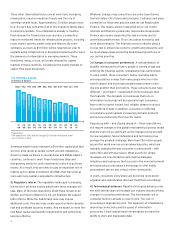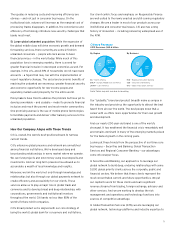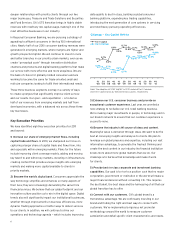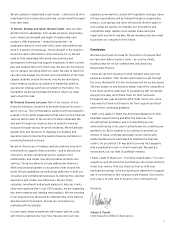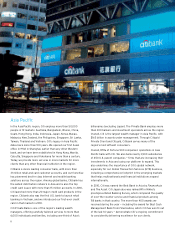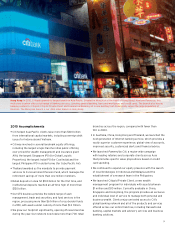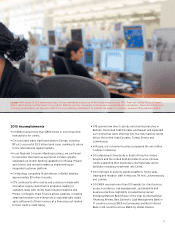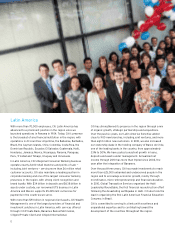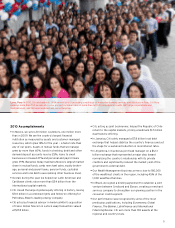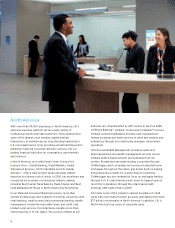Citibank 2010 Annual Report Download - page 6
Download and view the complete annual report
Please find page 6 of the 2010 Citibank annual report below. You can navigate through the pages in the report by either clicking on the pages listed below, or by using the keyword search tool below to find specific information within the annual report.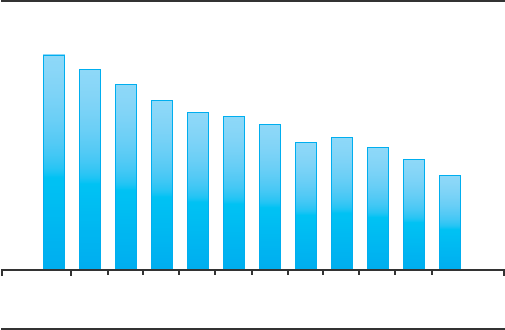
4
Three other interrelated factors are at work here: increasing
urbanization, massive investment needs and the role of
sovereign wealth funds. Approximately 1.5 million people move
to a city each day, with almost all of this migration taking place
in emerging markets. This urbanization already is creating
fresh demand for financial services and also is prompting
massive investment needs for infrastructure projects, including
roads, transit systems, power grids and telecom. By some
estimates, as much as $3 trillion will be required per year to
upgrade aging infrastructure in developed markets and to meet
the demands of urbanization in emerging markets. These
investment needs, in turn, will create demand for capital
markets in these countries, including active equity markets to
support the expected growth.
Sovereign wealth funds represent a $4 trillion capital pool that
will only grow larger as global current account imbalances,
driven by trade surpluses in several Asian and Middle Eastern
countries, continue to swell. These funds have large and
fast-growing needs for solid investments in which to put their
money. As a result, they are likely to play an important role in
making up for capital investment shortfalls that may arise as
more and more capital is allocated to infrastructure.
2) Regulatory reform: The regulatory landscape is changing,
but we don’t yet know exactly what forms those changes will
take. Many of the rules required by Dodd-Frank remain to be
written, and much of Basel III is not yet finalized. We support
both reforms. While the Dodd-Frank rules may impose
additional costs, they also may create opportunities to develop
new and profitable business models. And we expect to meet the
new Basel capital and liquidity requirements well before they
become effective.
Whatever changes may come, there are some clear themes
that will define Citi’s future and principles. Customers will place
a premium on those who practice what we call Responsible
Finance. This means acting in ways that are in our clients’
interests and that are systemically responsible. Responsible
Finance also means supporting the real economy and its
underlying growth trends. This is less about economics and
more about behavior. The financial services industry plays a
crucial role in enhancing economic growth and prosperity, and
we must always make promoting broad-based growth one of
our central priorities.
3) Changes in consumer preferences: A new generation of
globally minded and tech-savvy people is coming of age and
entering the financial system. Globalization has harmonized,
to some extent, these consumers’ tastes, spending habits
and expectations in ways that make people who live in the
world’s largest and most sophisticated urban centers more
like one another than ever before. These consumers also have
different — and higher — expectations from businesses than
their parents. The demands on businesses that rely on
information technology will be especially high: consumers
have come to expect instant, fast, reliable, always-on access
to a plethora of data. In addition, consumers in differing
circumstances and markets increasingly demand products
and services tailored to their specific needs.
Keeping up with — and staying ahead of — those expectations
will require changes to the global retail banking business model
that are every bit as significant as the changes being wrought
by new regulation. Social networking and technology pose
perhaps the greatest challenge. More than 750 million people
around the world now use social networking sites, which are
radically changing the way consumers communicate — with
each other and with businesses. What used to be simple
messages are now interactive and ongoing dialogues.
Industries and businesses that succeed in the new environment
are harnessing social network technology to offer highly
personalized service and virtual, online communities.
In short, consumers everywhere are becoming more knowl-
edgeable and sophisticated. We must treat them accordingly.
4) Technological advances: Rapid technological advances over
the next several years will reshape our industry beyond driving
changes in consumer preferences. The incremental cost of
computer memory already is close to zero. The cost of
processing is approaching zero. The expansion of broadband is
improving connectivity and the speed of information
processing. Cloud computing will meaningfully increase the
ability to store and manipulate data.
1Q
’08
3Q
’08
1Q
’09
3Q
’09
1Q
’10
3Q
’10
2Q
’08
4Q
’08
2Q
’09
4Q
’09
2Q
’10
4Q
’10
$8271705 599 556 5032421762 650 582 487 465 359
Citi Holdings Assets
(in billions of dollars)
1Peak quarter.
2The adoption of SFAS 166/167 brought $43 billion on balance sheet
as of January 1, 2010.

